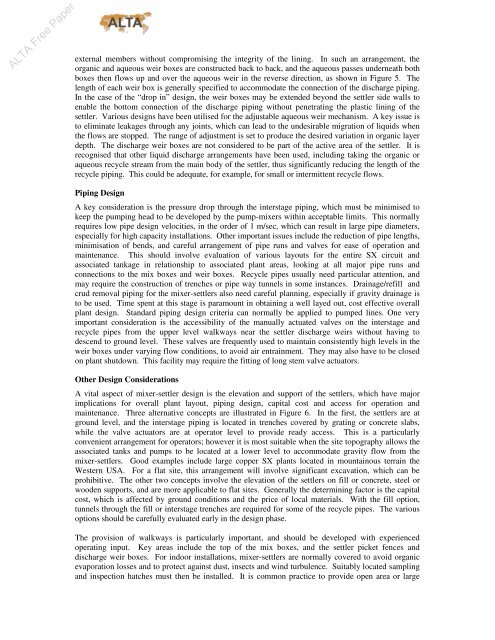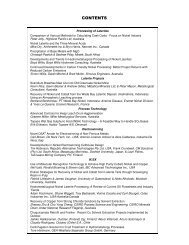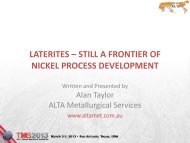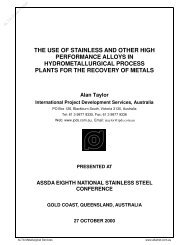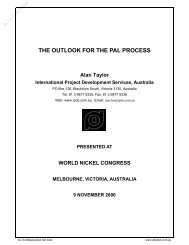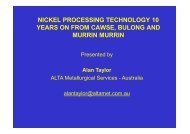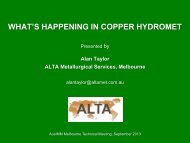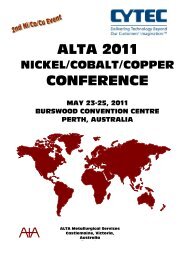solvent extraction mixer-settler design - ALTA Metallurgical Services
solvent extraction mixer-settler design - ALTA Metallurgical Services
solvent extraction mixer-settler design - ALTA Metallurgical Services
Create successful ePaper yourself
Turn your PDF publications into a flip-book with our unique Google optimized e-Paper software.
<strong>ALTA</strong> Free Paper<br />
external members without compromising the integrity of the lining. In such an arrangement, the<br />
organic and aqueous weir boxes are constructed back to back, and the aqueous passes underneath both<br />
boxes then flows up and over the aqueous weir in the reverse direction, as shown in Figure 5. The<br />
length of each weir box is generally specified to accommodate the connection of the discharge piping.<br />
In the case of the “drop in” <strong>design</strong>, the weir boxes may be extended beyond the <strong>settler</strong> side walls to<br />
enable the bottom connection of the discharge piping without penetrating the plastic lining of the<br />
<strong>settler</strong>. Various <strong>design</strong>s have been utilised for the adjustable aqueous weir mechanism. A key issue is<br />
to eliminate leakages through any joints, which can lead to the undesirable migration of liquids when<br />
the flows are stopped. The range of adjustment is set to produce the desired variation in organic layer<br />
depth. The discharge weir boxes are not considered to be part of the active area of the <strong>settler</strong>. It is<br />
recognised that other liquid discharge arrangements have been used, including taking the organic or<br />
aqueous recycle stream from the main body of the <strong>settler</strong>, thus significantly reducing the length of the<br />
recycle piping. This could be adequate, for example, for small or intermittent recycle flows.<br />
Piping Design<br />
A key consideration is the pressure drop through the interstage piping, which must be minimised to<br />
keep the pumping head to be developed by the pump-<strong>mixer</strong>s within acceptable limits. This normally<br />
requires low pipe <strong>design</strong> velocities, in the order of 1 m/sec, which can result in large pipe diameters,<br />
especially for high capacity installations. Other important issues include the reduction of pipe lengths,<br />
minimisation of bends, and careful arrangement of pipe runs and valves for ease of operation and<br />
maintenance. This should involve evaluation of various layouts for the entire SX circuit and<br />
associated tankage in relationship to associated plant areas, looking at all major pipe runs and<br />
connections to the mix boxes and weir boxes. Recycle pipes usually need particular attention, and<br />
may require the construction of trenches or pipe way tunnels in some instances. Drainage/refill and<br />
crud removal piping for the <strong>mixer</strong>-<strong>settler</strong>s also need careful planning, especially if gravity drainage is<br />
to be used. Time spent at this stage is paramount in obtaining a well layed out, cost effective overall<br />
plant <strong>design</strong>. Standard piping <strong>design</strong> criteria can normally be applied to pumped lines. One very<br />
important consideration is the accessibility of the manually actuated valves on the interstage and<br />
recycle pipes from the upper level walkways near the <strong>settler</strong> discharge weirs without having to<br />
descend to ground level. These valves are frequently used to maintain consistently high levels in the<br />
weir boxes under varying flow conditions, to avoid air entrainment. They may also have to be closed<br />
on plant shutdown. This facility may require the fitting of long stem valve actuators.<br />
Other Design Considerations<br />
A vital aspect of <strong>mixer</strong>-<strong>settler</strong> <strong>design</strong> is the elevation and support of the <strong>settler</strong>s, which have major<br />
implications for overall plant layout, piping <strong>design</strong>, capital cost and access for operation and<br />
maintenance. Three alternative concepts are illustrated in Figure 6. In the first, the <strong>settler</strong>s are at<br />
ground level, and the interstage piping is located in trenches covered by grating or concrete slabs,<br />
while the valve actuators are at operator level to provide ready access. This is a particularly<br />
convenient arrangement for operators; however it is most suitable when the site topography allows the<br />
associated tanks and pumps to be located at a lower level to accommodate gravity flow from the<br />
<strong>mixer</strong>-<strong>settler</strong>s. Good examples include large copper SX plants located in mountainous terrain the<br />
Western USA. For a flat site, this arrangement will involve significant excavation, which can be<br />
prohibitive. The other two concepts involve the elevation of the <strong>settler</strong>s on fill or concrete, steel or<br />
wooden supports, and are more applicable to flat sites. Generally the determining factor is the capital<br />
cost, which is affected by ground conditions and the price of local materials. With the fill option,<br />
tunnels through the fill or interstage trenches are required for some of the recycle pipes. The various<br />
options should be carefully evaluated early in the <strong>design</strong> phase.<br />
The provision of walkways is particularly important, and should be developed with experienced<br />
operating input. Key areas include the top of the mix boxes, and the <strong>settler</strong> picket fences and<br />
discharge weir boxes. For indoor installations, <strong>mixer</strong>-<strong>settler</strong>s are normally covered to avoid organic<br />
evaporation losses and to protect against dust, insects and wind turbulence. Suitably located sampling<br />
and inspection hatches must then be installed. It is common practice to provide open area or large


